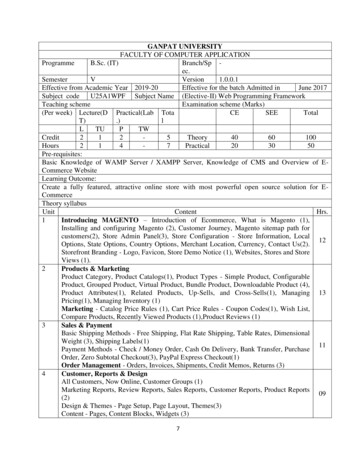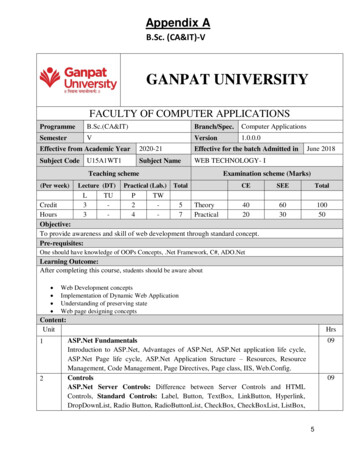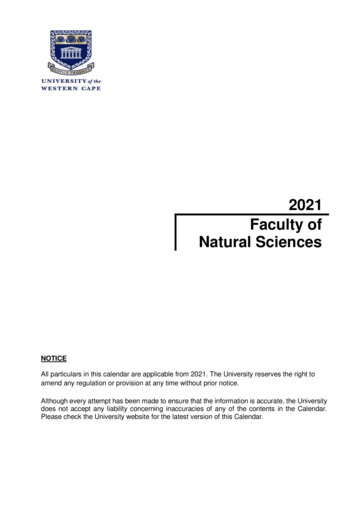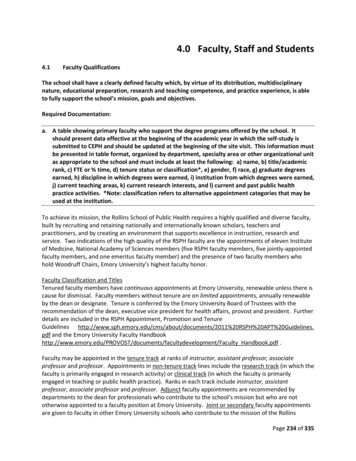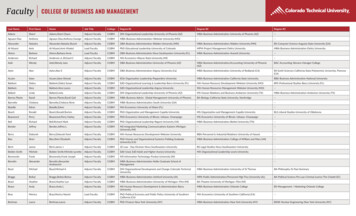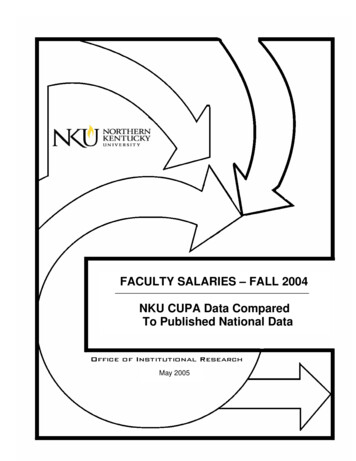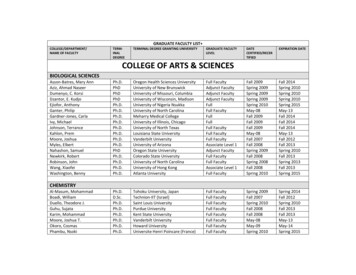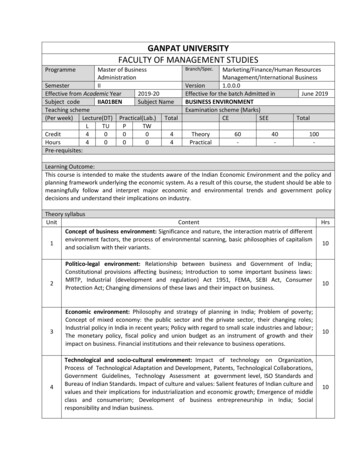
Transcription
GANPAT UNIVERSITYFACULTY OF MANAGEMENT STUDIESProgrammeMaster of BusinessAdministrationSemesterIIEffective from Academic Year2019-20Subject codeIIA01BENSubject NameTeaching scheme(Per week) Lecture(DT) Practical(Lab.) nch/Spec.Marketing/Finance/Human ResourcesManagement/International BusinessVersion1.0.0.0Effective for the batch Admitted inJune 2019BUSINESS ENVIRONMENTExamination scheme (Marks)CESEETotalTheoryPractical60-40-100-Learning Outcome:This course is intended to make the students aware of the Indian Economic Environment and the policy andplanning framework underlying the economic system. As a result of this course, the student should be able tomeaningfully follow and interpret major economic and environmental trends and government policydecisions and understand their implications on industry.Theory syllabusUnitContentConcept of business environment: Significance and nature, the interaction matrix of differentenvironment factors, the process of environmental scanning, basic philosophies of capitalism1and socialism with their variants.234Politico-legal environment: Relationship between business and Government of India;Constitutional provisions affecting business; Introduction to some important business laws:MRTP, Industrial (development and regulation) Act 1951, FEMA, SEBI Act, ConsumerProtection Act; Changing dimensions of these laws and their impact on business.Economic environment: Philosophy and strategy of planning in India; Problem of poverty;Concept of mixed economy: the public sector and the private sector, their changing roles;Industrial policy in India in recent years; Policy with regard to small scale industries and labour;The monetary policy, fiscal policy and union budget as an instrument of growth and theirimpact on business. Financial institutions and their relevance to business operations.Technological and socio-cultural environment: Impact of technology on Organization,Process of Technological Adaptation and Development, Patents, Technological Collaborations,Government Guidelines, Technology Assessment at government level, ISO Standards andBureau of Indian Standards. Impact of culture and values: Salient features of Indian culture andvalues and their implications for industrialization and economic growth; Emergence of middleclass and consumerism; Development of business entrepreneurship in India; Socialresponsibility and Indian business.Hrs10101010
56Liberalisation in India: The New Economic Policy; Globalisation; Policy changes forliberalisation-Industrial policy; Exim policy; Banking policy; FDI policy; Reforms in capitalmarket; Structural reforms; Impact of reform measures, Salient Features of WTO.Natural Environment: Economic Development and Pollution, Increased Pollution Levels,Changing role of Government, Regulations and its impact on business & industry, GreenMarketing, Environmental Technology, Ecological implications of technology, SustainableDevelopment.Practical contentText Books1Cherunilam, Fransis – Business Environment: Text & Cases (Himalaya Publication), Latest EditionReference Books1 Paul, Justine- Business Environment: Text & Cases (Tata McGraw-Hill), Latest edition.2 Cherunilam, Francis- Business Environment: Text & Cases (Himalaya Publishing). Latest edition.Shaikh Saleem- Business Environment (Pearson), Latest edition.345678910111213 Adhikari M- Economic Environment of Business (Excel Books), 2000, 8th ed, Sultan Chand.Ghosh- Economic Environment of Business (Vikas), 2004.Morrison J- The International Business Environment (Palgrave, 2003).Agarwal R- Business Environment (Excel Books), 2002.Bedi S K- Business Environment (Excel Books), 2004.George A and Steiner G A- Business, Government and Society (Macmillan).Ashwathappa - Business Environment (Himalaya Publishing), 2006, Latest Edition.Kuppuswamy, B- Social Change in India (Vikas Publishing), Latest Edition.Kreps- Microeconomics for managers (Norton), 2007.Paul, Justine- Business Environment: Text & Cases (Tata McGraw-Hill), Latest edition.The student will be aware of the Indian Economic environment and policy and planningframework in the system.The student should be able to meaningfully follow and interpret major economic andenvironmental trends government policy decisions.The students able to understand their implications of environment on industry.Note:Version 1.0.0.0 (First Digit New syllabus/Revision in Full Syllabus, Second Digit Revision in TeachingScheme, Third Digit Revision in Exam Scheme, Forth Digit Content Revision)L Lecture, TU Tutorial, P Practical/Lab., TW Term work, DT Direct Teaching, Lab. Laboratory workCE Continuous Evaluation, SEE Semester End Examination1010
GANPAT UNIVERSITYFACULTY OF MANAGEMENT STUDIESProgrammeMaster of BusinessAdministrationSemesterIIEffective from Academic Year2019-20Subject code2IIA02CMASubject NameTeaching scheme(Per week) Lecture(DT) Practical(Lab.) nch/Spec.Marketing/Finance/Human ResourcesManagement/International BusinessVersion1.0.0.1Effective for the batch Admitted inJune 2019COST AND MANAGEMENT ACCOUNTINGExamination scheme (Marks)CESEETotalTheoryPractical60-40-100-Learning Outcome:The objective of this course is to acquaint students with various concepts of costing and highlight thedecision-making and control focus of managerial accounting. Simple to gradually difficult case situations aretakes up to the students.Theory syllabusUnitContentIntroduction: Managerial accounting and the business organization, Accounting forManagement, Role of Cost in decision making, Management Accounting and Cost Accounting1as internal control tools, types of cost, cost concepts, Cost behaviour and Measurement of costbehaviour, full costing, overhead allocations, preparation of cost sheet.2Marginal Costing: Cost, Volume, Profit analysis, P/V ratio, analysis and implications, Conceptand uses of contribution, Advanced Breakeven point and its analysis for the various types ofdecision-making like single product pricing, multi product pricing, replacement, sales etc.Differential Costing and incremental costing;: concept, uses and applications, Method ofcalculation of these cost and its role in management decision making like sales, replacement,buying etc, Relevant information and decision making, Make vs Buy.Budgeting: Concept of Budget, Budgeting and Budgetary Control, Types of Budget, Static andFlexible Budgeting, Preparation of Cash Budget, Sales Budget, Production Budget, MaterialsBudget, Capital Expenditure Budget and Master Budget, Advantages and Limitations ofBudgetary Control.Hrs12123Capital Budgeting analysis: Net Present value124Standard Costing: Concept of standard costs, establishing various cost standards, calculation ofMaterial Variance, Labour Variance, and Overhead Variance, and its applications andimplications.Allocation and Transfer Price: Death Spiral, Economic Value added ,Responsibility AccountingConcept and various approached to responsibility accounting, concept of investment center,cost center, profit center and responsibility center and its managerial implications, TransferPricing Multinational transfer pricing, market based transfer pricing, cost-based transferpricing, Cost of Quality and Time,12
5Neo Concepts for Decision Making: Concept, distinctive features of Activity Based Costing,Cost Drivers, Cost of Activities, Cost object such as product, service, customer. CostManagement: concept, strategies and applications. Value Chain Analysis, Target Costing, LifeCycle Costing.Practical contentText Books1Cost Accounting, A Managerial Emphasis; 14th Edition ; by Horngren, Foster and DatarReference Books1 Horngren et al- Introduction to Management Accounting (Pearson, 12th edition), 20022 Khan and Jain- Management Accounting (Tata McGraw-Hill, 2000) 3rd ed.rd3 Pandey I M- Management Accounting (Vikas, 3 edition), 2004.4 Bhattacharyya S K and Dearden J- Accounting for Management (Vikas), 1987, 8th ed.5 Sahaf M A- Management Accounting: Principles and Practice (Vikas), 2000. The objective of this course is to acquaint students with various concepts of costs and processused to determine product costs.To be able to utilize Activity Based Costing and compare this with other costing systems. Studentwill be able to analyse and apply flexible and static budgets and variance analysis.Explain the relationship between cost accounting, financial accounting and Managementaccounting.Note:Version 1.0.0.0 (First Digit New syllabus/Revision in Full Syllabus, Second Digit Revision in TeachingScheme, Third Digit Revision in Exam Scheme, Forth Digit Content Revision)L Lecture, TU Tutorial, P Practical/Lab., TW Term work, DT Direct Teaching, Lab. Laboratory workCE Continuous Evaluation, SEE Semester End Examination12
GANPAT UNIVERSITYFACULTY OF MANAGEMENT STUDIESProgrammeMaster of BusinessAdministrationSemesterIIEffective from Academic Year2019-20Subject code2IIA03MMA Subject NameTeaching scheme(Per week) Lecture(DT) Practical(Lab.) nch/Spec.Marketing/Finance/Human ResourcesManagement/International BusinessVersion1.0.0.1Effective for the batch Admitted inJune 2019MARKETING MANAGEMENTExamination scheme (Marks)CESEETotalTheoryPractical60-40-100-Learning Outcome:This course develops the student’s basic analytical skills, conceptual abilities, and substantive knowledge inmarketing through exercise in decision making in a variety of real-life marketing situations. It is intended to befoundation for those who plan to do further work in marketing in the second year. It is also designed to serveas a terminal course for those not intending to specialize in marketing.Theory syllabusUnitContentHrsNature and Scope of Marketing: Marketing’s value to consumers, firms & society; MarketingManagement, Philosophies; Marketing Environment; Consumer buying behaviour; Consumer110Markets and Industrial Markets and buying behaviour; Market measurement and forecasting,Improving decisions with marketing informationFocusing marketing strategy with Market Segmentation, Targeting and Positioning, SegmentingMarkets - Bases and Process, Market Segmentation and Product Differentiation, Target Market210Selection, Positioning — Nature, Importance and Process of Marketing Research.3456Elements of product planning for goods and services ,Marketing Mix decision:, ProductDecisions, New Product Development; Product Mix, Branding and Packaging Decisions; ProductLife Cycle; Pricing Decisions: Objectives and Determination, Methods of Setting Price andpricing strategies:Promotion: Promotion Mix-Advertising, Sales Promotion, Personal selling; and Public Relations:Direct Marketing & Relationship Marketing; Publicity Placement: Channels of distribution:Levels and types of channels, functions and management of channel members: ChannelSelection & Motivation; Management of Physical Distribution; wholesalers and retailers & theirstrategy planning ; Marketing Organisation and Control.Planning & Developing marketing strategy: differencing and positioning the market offering,developing new product, managing life-cycle strategies, designing marketing strategy formarket order challengers, followers and niches, Designing and managing global marketingstrategies.Emerging Trends & Issues in Marketing: Rural Marketing, CRM, Services marketing, B2BMarketing, Internet Marketing, Consumerism, Legal Issues, Broadening the marketing concept.10101010
Practical contentText Books1“Marketing Management: A South Asian Perspective”, Latest Edition, Pearson Education by PhilipKotler, Kevin Lane Keller, Abraham Koshy, Mithileshwar Jha.Reference BooksKotler, Philip, "Marketing Management: Analysis, Planning, Implementations and Control", Pearson1Education, New Delhi, Latest Edition.2 Saxena Rajan, "Marketing Management", Tata McGraw Hill, New Delhi , Latest Edition.3 Stanton William J., "Fundamentals of Marketing", McGraw Hill, Latest Edition.4 Kotler, Philip and Armstrong, Graw. "Principles of Marketing", Pearson Education, New Delhi 2004.5 Neelamegham, S., "Indian Cases in Marketing", Vikas Pub. New Delhi.6 Bull, Victor P., "Marketing Management: A Strategic Planning Approach", McGraw Hill, New York.7 Czinkota, M.R., "Marketing Management", Pearson Education Asia, New Delhi 2004.Michael, J. E., Bruce, J. W. and Williom, J. S., “Marketing Management”, Tata McGrawHill, New Delhi, 13th Edition,8 2004.9 Louis E. Boone and David L. Kurtz, “Contemporary Marketing”. Harcourt Collye Publishers, 2001.Douglas, J. Darymple & Leonard J. Parsons, “Marketing Management: Text and Cases”, Seventh Edition, John Wiley10 and Sons, 2002.11 Pride, William, M., and O.C. Ferrell, “Marketing: Concepts and Strategies”, Biztantra, New Delhi, 2005. The objective of the course is to develop the students ‘conceptual understanding and analyticalabilities in the area of Marketing Management.It aims to hone students ‘knowledge and understanding of Marketing theories and concepts andtheir applications in different industries.The course is designed to promote understanding of processes and techniques of managingmarketing operation and to develop a feel of the market place.Note:Version 1.0.0.0 (First Digit New syllabus/Revision in Full Syllabus, Second Digit Revision in TeachingScheme, Third Digit Revision in Exam Scheme, Forth Digit Content Revision)L Lecture, TU Tutorial, P Practical/Lab., TW Term work, DT Direct Teaching, Lab. Laboratory workCE Continuous Evaluation, SEE Semester End Examination
GANPAT UNIVERSITYFACULTY OF MANAGEMENT STUDIESProgrammeMaster of BusinessAdministrationSemesterIIEffective from Academic Year2016-17Subject code2IIA04FMASubject NameTeaching scheme(Per week) Lecture(DT) Practical(Lab.) nch/Spec.Marketing/Finance/Human ResourcesManagement/International BusinessVersion1.0.0.0Effective for the batch Admitted inJune 2016FINANCIAL MANAGEMENTExamination scheme (Marks)CESEETotalTheoryPractical60-40-100-Learning Outcome:The focus of this course is on the understanding of techniques and concepts and in showing their applicationto financial decision marketing situations.Theory syllabusUnitContentIntroduction: Concept of finance, scope and objectives of finance; Profit maximization vs.Wealth maximization; Functions of Finance Manager in Modern Age; Financial decision areas,Time value of money, risk and return analysis, valuation of securities; Analysis of Financial1Statements, Forecasting Financial Statements, corporate valuation.2345Working Capital: Concept of Gross Working Capital & Net Working Capital, Various Approachesto Working Capital Management, Factors affecting working capital requirement. WorkingCapital Management: Management of cash, inventory and receivables. Working CapitalFinancing: Sources of short term financing, Role of commercial bank in working capitalmanagement; Commercial paper; Factoring and other tools of working capital management.Investment decision: Appraisal of project; Techniques of capital budgeting and its applications;Risk and Uncertainty in Capital Budgeting, Leverage analysis-financing, operating and combinedleverage and its implications; EBIT-EPS analysis; Portfolio theories, Financial options.Financing Decision: Long-term sources of finance, potentiality of equity shares, preferenceshares, debentures and bonds as source of long-term finance; Concept and approaches ofcapital structure decision; NI, NOI, Traditional and Modigliani Miller Approach; Cost of equityshare, preference share and debentures; CAPM, Primary and Secondary Markets, leasefinancing, skim.Dividend Decision: Concept of retained earnings and plough back of profits, relevancy andirrelevancy theory of dividend decision; Walter's model; Gordon's Model and Modigliani Millermodel; Factor affecting dividend decision.Practical contentHrs1212121212
Text Books1Financial Management by I M Pandey, Nineth Edition, Vikas Publishing house Pvt. Ltd.Reference Books1 Pandey I M- Financial Management (Vikas, Latest Edition).2 Van Horne- Financial Management and Policy (Pearson Education, 12 edition) 2003.3 Knott G-Financial Management (Palgrave, 2004)4 Khan and Jain- Financial Management, Text, Problems & Cases (Tata McGraw-Hill, Latest Edition)5 Prasanna Chandra- Financial Management: Theory and Practice (TMH), Latest Edition.6 Kirt C Butler- Multi National Finance (Vikas).7 R P Rustagi- Financial Management (Galgotia) 2000, 2nd ed.8 Lawrence J. Gitman- Principles of Managerial Finance 2004, Pearson Education N. Delhi.9 Maheshwari, S.N.- Financial Management – Principles & Practice (Sultan Chand & Sons), Latest Edition. It also help students to showing application of subject for financial decision marketingsituations.The focus of this course is on the understanding of techniques and concepts in areal of Finance.It finally give focus approach for controlling financial aspects of organization through continuousfeedback system.Note:Version 1.0.0.0 (First Digit New syllabus/Revision in Full Syllabus, Second Digit Revision in TeachingScheme, Third Digit Revision in Exam Scheme, Forth Digit Content Revision)L Lecture, TU Tutorial, P Practical/Lab., TW Term work, DT Direct Teaching, Lab. Laboratory workCE Continuous Evaluation, SEE Semester End Examination
GANPAT UNIVERSITYFACULTY OF MANAGEMENT STUDIESProgrammeMaster of BusinessAdministrationSemesterIIEffective from Academic Year2019-20Subject code2IIA05POMSubject NameTeaching scheme(Per week) Lecture(DT) Practical(Lab.) nch/Spec.Marketing/Finance/Human ResourcesManagement/International BusinessVersion1.0.0.1Effective for the batch Admitted inJune 2019PRODUCTION AND OPERATIONS MANAGEMENTExamination scheme (Marks)CESEETotalTheoryPractical60-40-100-Learning Outcome:This course attempts to help students learn operations management systems and analysis issues pertaining tomanagement of productivity, manufacturing technology, and facilities, operations planning and control andmanagement of materials and quality.Theory syllabusUnitContentTransformation process model: Inputs, process and outputs; Classification of operations;Responsibilities of Operations Manager; New Product Development, Selection and Design ofProduct / Services, Competitiveness & strategy12345Process types in manufacturing: project, jobbing, batch, line, mass, continuous; Process typesin services: professional services, services shops, mass services; Plant location; facility layoutfor products and servicesProduction Planning & Control: Production planning techniques for various process choices,techniques of production control. Forecasting & Strategic Capacity Planning, Methods ofForecasting, Overview of Operation Planning, Aggregate Production Planning, Productionstrategies, Capacity Requirement Planning, MRP, Scheduling, Supply Chain Management,Purchase Management, Inventory Management, CPM and PERT.Quality management: Introduction; Meaning; Quality characteristics of goods and services;Tools and techniques for quality improvement: check sheet, histogram, scatter diagram, causeand effect diagram, Pareto chart, process diagram, statistical process control chart; Qualityassurance; Total quality management (TQM) model; Service quality, concept of Six Sigma andits application, JIT & Lean OperationsProductivity Improvement Techniques: Work study; Method study; Work measurement: timestudy: stop watch time study; Work sampling. Maintenance: maintenance policies for facilitiesand equipment; Time of failure; Preventive versus breakdown maintenance; Procedure formaintenance, total productive maintenance (TPM).Practical contentHrs1212121212
Text Books1Kanishka Bedi- Production & Operations Management.- (Oxford University Press)Reference Books1 Adam Jr Everetl E. R J Production and Operations Management (Prentice-Hall), 2000 5th ed.2 Chary- Production and Operations Management (Tata McGraw-Hill, 9th ed.)3 Hill T- Operations Management (Palgrave, 2000)4 Johnston R et al Cases in Operations Management (Pitman, 1993)5 McGregor D Operations Management (McGraw-Hill, 1960)6 Morton- Production and Operations Management (Vikas)7 Haleem A- Production and Operations Management (Galgotia books, 2004)8 Shanker Ravi- Industrial Engineering ( Galgotia)9 Chase- Production and operation Management, Irwin London; 7th ed.10 Kanishka Bedi- Production & Operations Management.- (Oxford University Press) To be able to understand the need of various optimization techniques used in production andoperation management.To understand the application of optimization techniques to improve the productivity.To learn about the various Quality Management Systems to improve the productivity.Note:Version 1.0.0.0 (First Digit New syllabus/Revision in Full Syllabus, Second Digit Revision in TeachingScheme, Third Digit Revision in Exam Scheme, Forth Digit Content Revision)L Lecture, TU Tutorial, P Practical/Lab., TW Term work, DT Direct Teaching, Lab. Laboratory workCE Continuous Evaluation, SEE Semester End Examination
GANPAT UNIVERSITYFACULTY OF MANAGEMENT STUDIESProgrammeMaster of BusinessAdministrationSemesterIIEffective from Academic Year2019-20Subject code2IIA06HRMSubject NameTeaching scheme(Per week) Lecture(DT) Practical(Lab.) nch/Spec.Marketing/Finance/Human ResourcesManagement/International BusinessVersion1.0.0.1Effective for the batch Admitted inJune 2019HUMAN RESOURCES MANAGEMENTExamination scheme (Marks)CESEETotalTheoryPractical60-40-100-Learning Outcome:: This course exposes students to the critical tasks and functions of Human Resources Management andunderstands the dynamics and processes of labour management relations. It helps students appreciaterelevant tools and techniques to internalize and critical functions of human resources management, andsensitize students to human resources developments processes.Theory syllabusUnitContentIntroduction to Human Resource Management: Nature and the development of personnelmanagement, historical context in India, the welfare tradition, the industrial relations tradition,the control of labor tradition, the professional tradition. Personnel function: personnel as a1specialist function, policies, strategies, and operating plans of personnel, and the personnelactivities. Human resource management (HRM): political, social, and social context of change,HRM within organization structure, Human Resource Management Strategy And Analysis.Personnel planning and recruiting: Human resources planning definition, purposes, Andprocesses and limiting factors; human resources information systems (HRIS): personnel recordsand statistics, the use of information systems in HRM, HR accounting and audit. Recruiting: Thesystematic approach to recruitment, recruitment policy, recruitment procedures, job analysis,2job description, personnel specification, recruitment methods, and evaluation. InterviewingCandidates: The systematic approach to selection, the selection procedure, the design ofapplication form, selection methods, the offer of employment, and evaluation of process.Training and development Employees: purpose, methods, and issues in training andmanagement development programs. Performance Management and Appraisal: definition,purpose of appraisal, procedures and techniques including 360 Degree Appraisal, the appraisalinterview, and follow up. Managing Employee Retention and Engagement: Reward3management, job evaluation, purposes and methods, factors affecting compensation policy,effect of job evaluation on human relations, compensation systems: base and variable, fringebenefits, benefits and services, pay for performance and financial incentives, the legalframework on pays and benefits.Discipline and grievance procedures: definition, disciplinary procedure model, the otherprocedures, grievance procedures and interview. Industrial relations: aspect of industrialrelations (IR), nature and importance of union-management relations, Ethics, Employee4Relation and fair treatment at work , Labor relation and collective Bargaining, Employee safetyand healthHrs12121212
5Termination of employment: retirement, resignation, and termination of contract: layoff andexit interviews. Dealing with the human aspects of terminations: procedures for terminations,counseling, training and notice of dismissalPractical contentText Books1Aswathappa- Human Resource Management (Tata McGraw-Hill) HR and PM, 2003, 3rd ed.Reference Books1 Bratton J and Gold J- Human Resource Management: Theory and Practice (Palgrave, 2003)2 Gomez-Mejia et al- Managing Human Resources (Pearson Education, 3rd edition),3 Ivansevich- Human Resource Management (Tata McGraw-Hill)4 Aswathappa- Human Resource Management (Tata McGraw-Hill) HR and PM, 2003, 3rd ed.5 Dessler- Human Resource Management (Prentice-Hall, 9th edition)A.K.Singh, B.R.Duggal, Puneet Mohan- Human Resource Management and Development (Sun India6 Publication, 2004).7 Mamoria,Mamoria & Gankar- Dynamics of Industrial Relations in India,Himalaya.8 Gary Dessler- Human Resource Mgt., Pearson/PHI9 V.S.P. Rao- Human Resource Management, Excel Book10 G.P.Sinha and P.R.V.sinha – Industrial Relations and Labour Legislation in India, Himalaya11 P.L.Rao- Human Resource Management, Excel Books.12 Baron– Strategic Human Resources : Framework for general Managers-John Wiley13 S. C. Gupta– Text Book of International HRM – Macmillan14 Greer– Strategic Human Resource Management – Pearson15 Mamoria and mamoria– Dynamics of Industrial Relation , Himalaya Publishing16 Venkat Ratnam– Globalization and Labour Mgt. Relations, Sage Publications, New Delhi To acquire knowledge about critical task & function of human resource management.To be able to know about the dynamic process of labour management relations.Will acquire knowledge about relevant tools &techniques of HRM.Note:Version 1.0.0.0 (First Digit New syllabus/Revision in Full Syllabus, Second Digit Revision in TeachingScheme,Third Digit Revision in Exam Scheme, Forth Digit Content Revision)L Lecture, TU Tutorial, P Practical/Lab., TW Term work, DT Direct Teaching, Lab. Laboratory workCE Continuous Evaluation, SEE Semester End Examination12
GANPAT UNIVERSITYFACULTY OF MANAGEMENT STUDIESProgrammeMaster of BusinessAdministrationSemesterIIEffective from Academic Year2019-20Subject code2IIA07BRM Subject NameTeaching scheme(Per week) Lecture(DT) Practical(Lab.) nch/Marketing/Finance/Human ResourcesSpec.Management/International BusinessVersion1.0.0.1Effective for the batch Admitted inJune 2019BUSINESS RESEARCH METHODOLOGYExamination scheme (Marks)CESEETotalTheoryPractical60-40-100-Learning Outcome:The objective of this course is to familiarize the students with the concepts and testing of hypotheses,Statistical tools and techniques for undertaking research project in business and writing research reports in anacceptable form.Theory syllabusUnitContentHrsIntroduction to SPSS: Defining the variables; feeding the data; compute the data; handlingmultiple response categories, dealing with missing value. Data Analysis and Interpretations: 101Frequency Distribution, Cross Tabulation, Descriptive statistics, Graphs.Sampling distribution: parameter and statistics; Estimation: Confidence interval and samplesize determination. Hypothesis testing: process, type I and type II error, power of test. Dataanalysis: Univariate, Bivariate and Multivariate2Test for means: Z-test, student’s t test: one sample test; two independent sample test and two 20dependent sample test (paired sample test). Test for proportions: one sample and two sampletest.Non-parametric test: Chi-square Test: Test of association, Goodness of fit, Strength ofassociation, Analysis of Variance (ANOVA): One-way ANOVA, Two-way ANOVA (with SPSS);3Multivariate Analysis of Variance (MANOVA) (with SPSS). Strength of effect. Post hoc analysis 15for ANOVA and MANOVA (with SPSS).Correlation: Bivariate and multiple; Simple regression; Multiple regression (with SPSS); dealingwith the collinearity; Exploratory Factor analysis (with SPSS); Other Non-parametric tests (withSPSS): Run test; Binomial test; Sign test; Wilcoxon matched-pairs test; Mann-Whitney rank-sum4test and Fridman one-way ANOVA. Report Preparation: Types and layout of research report. 15Precautions in preparing the research report. Bibliography and Annexure in report. Drawingconclusions. Giving suggestions and recommendations to the concerned persons.Practical contentText Books1Levin R and Rubin D- Statistics for Management (Pearson Education, 7th edition)2Malhotra, Naresh K.- Marketing Research. Pearson Education, Latest Edition.Reference BooksBusiness Research Methods: A South-Asian Perspective, 8e, by Zikmund, Babin, Carr, Adhikari and Griffin: CENGAGE1Learning2Zikmund W - Business Research Methods, Thomson/South-Western.Cooper D and Schindler P- Business Research Methods (Tata McGraw-Hill).3
Hair, Black, Babin, Anderson and Tatham- Multivariate Data Analysis (Pearson Education, 6th edition).Nargundakar R- Marketing Research: Text and Cases ((Tata McGraw-Hill).David J. Luck and Ronald S. Ruben- Marketing Research (Prentice Hall of India), Latest Edition.Srivastava T and Rego S- Statistics for Management ((Tata McGraw-Hill).Krishnaswamy K.N.,Sivakumar, Mathirajan- Management Research Methodology, Pearson.Paneerselvam, R.- Research Methodology, PHI, New Delhi.Easwaran & Singh- Marketing Research: Concepts, Practice and Cases – Oxford.Pati D- Marketing Research, Universities Press.George D and Mallery P- SPSS for Windows – step by step (Pearson Education, 10th edition)Collis J and Hussey R- Business Research (Palgrave, 2003).45678910111213 To be able to select appropriate statistical test according to the research objectives.Acquire the ability to apply statistical analysis using data analysis sof
Programme Master of Business Administration Branch/Spec. Marketing/Finance/Human Resources Management/International Business Semester II Version 1.0.0.0 Effective from Academic Year 2019-20 Effective for the batch Admitted in June 2019 Subject code IIA01BEN Subject Name BUSINESS ENVIRONMENT Teaching scheme Examination scheme (Marks)

